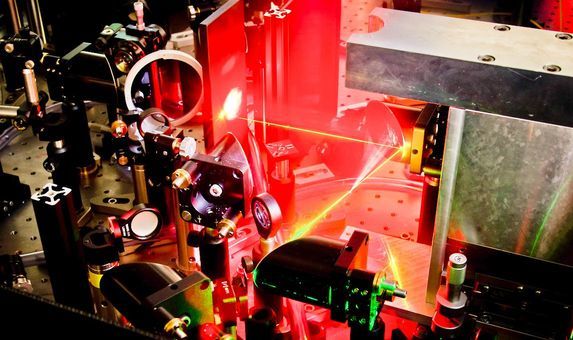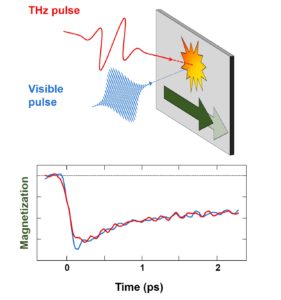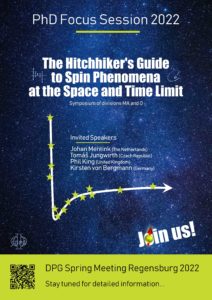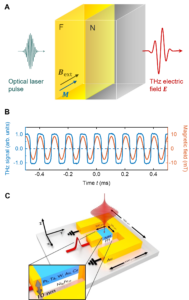
The Terahertz Physics Group studies phenomena that occur at extremely high frequencies in the so-called terahertz (THz) region from about 1 to 30 THz. This spectral range is still quite unexplored although it coincides with numerous fundamental resonances and relaxation processes in condensed matter. Important examples are crystal-lattice vibrations (phonons), spin waves (magnons), excitons (bound electron-hole pairs) and the scattering of conduction electrons (velocity relaxation).
To study and ultimately control these motions, we develop new and sensitive optical methods based on ultrashort electromagnetic THz fields and optical laser pulses. To better understand our experimental results, we work out simple theoretical models.
Examples of important questions we address are:
- How do lattice vibrations affect the state of the electrons and their spins?
- How can we control the ultrafast transport of electrons or spins through nanostructures?
- How are dynamics modified close to interfaces?
- How do molecules in liquids and soft matter react to strong pulsed THz electric fields?
A better understanding of the dynamics of complex materials at their natural (THz) frequencies is relevant for future applications because bit rates in information technology are gradually approaching the THz range, for instance in wireless networks and field effect transistors. We also explore our results directly for applications in THz photonics, including the development of novel emitters, detectors and modulators of broadband THz radiation.
We participate in national and international research collaborations: the DFG-funded Collaborative Research Center/Transregio 227 on Ultrafast Spin Dynamics and the EU-funded projects ASPIN, SKYTOP and s-NEBULA.
NEWS


When a ferromagnet such as iron is heated, its magnetization decreases because the ordered electron spins (which can be thought of as little compass needles) are forced to fluctuate more strongly. Heating of the magnet can be done extremely fast by a femtosecond laser pulse. Iron and nickel are known to decrease their magnetization in a time as short as 100 fs. This ultrafast demagnetization provides fundamental insights into the coupling of electrons with their ordered spins.
“It is important to realize that the laser [more...]

The growing hunger of society for fast data storage and processing, together with the end of Moore’s law, demand the development of new technologies to implement smaller, faster and more power-efficient devices. Research in magnetic materials has shown the potential of spin-based devices in this regard. Pushing for “More than Moore” devices, space and time limits need to be tackled. At the heart of this research are three fundamental operations: Control of magnetic order, spin transport and efficient monitoring of spin angular momentum in space and time. Topical clusters ranging from ferro- to antiferromagnets up to 2D materials, magnetic-organic interfaces and heterostructures are extensively studied. New materials [more...]
Both awardees underwent a competitive preselection procedure and could successfully compete during the finalists’ session. Dr. Annika Johansson presented her results related to the calculation of spin to charge conversion mechanisms like the Rashba-Edelstein effect in [more...]

To trigger the emission of ultrashort THz electromagnetic pulses, an STE is driven by femtosecond laser pulses (Figure A). STEs have unique properties: First, the polarization (i.e. the alignment) of the THz electric fieldis always perpendicular to the magnetization M of the STE, which, in turn, is straightforwardly controlled by the external magnetic field Bext. Second, because they are made of extremely thin metal layers, STEs can easily be shaped for integration [more...]